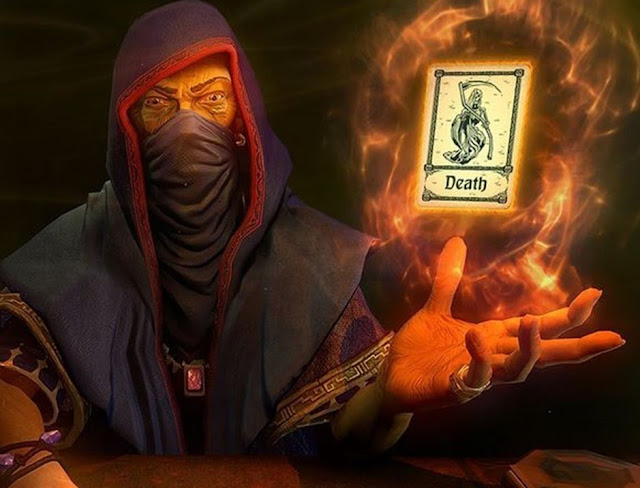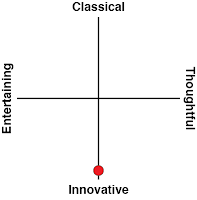Review by Matt S.
When Hand of Fate first released back in 2015, it was something genuinely new that people hadn’t seen before, and that made it a hugely impressive effort for a small Australian game developer. Now the team is back with a sequel, and the fact that it’s that much better than its already-superb original is quite incredible. This is, without a doubt, one of the most rounded and enjoyable games Australia has ever produced.
Related reading: Matt’s review of the first Hand of Fate.
It’s a difficult game to easily explain in words, which is why I’ve created a video to show off some of the games systems (below). If I was to describe Hand of Fate 2 as a mix of board game, card game, RPG, choose-your-own-adventure storytelling, and action game, I’d be more-or-less accurate, but I’d also be doing the game a disservice by implying that it is a soup of various genres, rather than a single, cohesive whole. That’s what’s so impressive about Hand of Fate 2; it draws together so many different elements in such a way that, as you play, all you see and feel is one holistic, seamless picture. It moves so seamlessly and effectively from a board game that uses randomly dealt cards as spaces, to getting you to throw dice to decide the outcome of your latest risky venture, and on to counter-heavy the counter-heavy action that we see in so many blockbusters today, that you’ll wonder why other developers haven’t cottoned on to this approach to gameplay yet. You’ll find yourself reading the equivalent of pages of text without really realising just how much of it there is. It’s all so absorbing that it’s impossible to put down, and it’s so much more than the sum of all its parts.
Part of what makes the game so fascinating is the enigmatic fortune teller that acts as the narrator and rumbles on at you as you carefully pick your way across the board of cards dealt to you at the start of each scenario. The aesthetics and design of the game fit in closely with the whole fantasy “gypsy” tradition, gothic horse drawn cart and all, and that lends the game an appealing sense of dark fantasy.
It also subtly taps into the traditions of old Dungeons & Dragons and pen and paper RPGs, that I’m almost certain some of the team at developer, Defiant Development, are themselves fans of. One of the earliest, and most well regarded Dungeons & Dragons adventures was called Castle Ravenloft, and what most people remember fondly about that one is that it kicked off with a tarot card reading. The deterministic power behind the cards as they’re presented in these games, by a wizened and enigmatic being with their divination magics, is obviously as core to this fantasy aesthetic as the genie and harem costume is to Arabian fantasy. And that is fortunate, because that motif is a good fit for games of all kinds, too, since a portent told through cards that gives game developers a “gamey” trope to work with that also builds aesthetic credibility, as well as injecting a sense of mystery to the setting. I’m not sure if the developers of Hand of Fate 2 have actually played Castle Ravenloft (though it would not surprised me in the slightest), but whether coincidental or not, just as that classic game used the cards to set the scene, so too does this game, and it does so perfectly.
Tonally the game is spot on, too. Each card has a story to tell, and whether it’s an ambush by desperate robbers, a carnivorous plant looking to make you its next meal, or an ancient forest dweller willing to give you a rare respite, each description drips with that dark fantasy theme and atmosphere. Because the cards are randomly drawn to form the game board that you move your character across, there is a certain disjointedness in how these stories are told, and yet that too fits with the spirit of adventure; you might only be looking at cards on a table, but their descriptions paint the image of scenes from some truly epic quests, and leaves plenty of room for you to fill the blanks between scenes for yourself. I found myself drawn far more into the world of Hand of Fate 2 than I have been in certain blockbuster open world games that aim also aim for the dark fantasy aesthetic (hello Lord of the Rings: Shadow of War), and that’s because the game plays on the imagination, rather than forcing a vision (such as a sexy spider woman replacing Shelob) down the player’s throat.
All of the above is true of the original Hand of Fate. The sequel’s refinements are predominantly mechanical, but they do help broaden and deepen the game, and it’s all the more immersive as a result. In addition to combat refinements, which add a greater variety of enemies to fight and really force players to drop any expectation of button mashing in order to be strategic about using counters, dodges, and guard breaks on enemies, there’s also a new companion mechanic to provide further strategic depth to the action. You’re also able to choose one companion into battle, who can both contribute to the fight themselves, and provide boosts and boons to your own character. Each of these characters adds something substantially different to the action, and I often found myself retrying scenarios with different companions just to see if I could make things easier on myself.
If you’re ever in a bar fight you CLEARLY want me on your side. Hand of Fate 2 is brilliant. #PS4share pic.twitter.com/rtSAX6Uv3s— DDNet (@DigitallyDownld) November 8, 2017
Hand of Fate 2 has also added a world map, from which you select scenarios to complete. It’s a fairly linear adventure, though you’ll generally have a couple of different options for which scenario you’ll take on next. More importantly, this map, which was not present in the original game, adds a critical sense of place and lore to the world. We’re not quite at the point yet where the game’s world feels fully realised, as there’s still an inability to directly interact with the world in any meaningful way, but Defiant Development is coming tantalising close to offering players a spectacular setting, and I did leave wanting to know so much more about what the world offers.
And of course there are new cards to play with. So many new cards. As with the first game, every time you complete a scenario, some new cards are added to your deck, and from that deck you’ll pick a certain number of cards to take into the next scenario. What’s different is the variety in what the cards offer is that much greater, so there’s a great deal of strategy involved in picking the right cards that will equip you for the challenges ahead, keep you fed and healthy, and provide you with some coin to deal with commercial challenges. Once I had a sizable deck of the cards I had genuine difficulty in picking the right cards that would suit my play style, especially given that every new card is another snippet of storytelling, and I wanted to experience them all at least once just for that reason.
Defiant Development have also crafted a beautiful game, and a significant jump ahead of its predecessor. It’s not so noticeable when you’re looking at the board of cards itself – that’s a static miniature representing your character and cards are cards and looks much of a muchness with the first game. It is, however, very noticeable in the combat, where backgrounds are detailed, lighting is gorgeous, and enemies are designed and animated to a standard that rivals any other action RPG you’d see out there. There was the very rare moment where the combat would stutter, even on my PlayStation 4 Pro, but it was never enough to affect my performance, nor ruin the flow of the rhythmical and dynamic combat.
— DDNet (@DigitallyDownld) November 7, 2017
The one and only real question mark remains over the endless mode, which was the disappointment of the first Hand of Fate. Scenarios limited you to a certain number of cards, played in a certain array. The endless mode was, potentially, the secret weapon for the first Hand of Fate’s longevity, where you would set up a deck of cards, and then, as you cleared one layout, you’d be dealt another one, until your character finally falls and you’re given a score. Trying to top that score could have been so incredibly addictive. But in the first Hand of Fate, that mode was far too easy for far too long, and who wants to spend an hour working through a cakewalk, only to hit a massive difficulty spike and get the game over screen soon after? Hand of Fate 2’s endless mode is “coming soon” at time of writing, and I only hope there’s a better balance and difficulty curve to it this time.
Defiant Development has proven that Hand of Fate was neither a one-off hit, nor that it couldn’t be expanded on in a meaningful way. Hand of Fate 2 retains the aesthetics and soul of the original game, but builds on the world’s lore, its mechanics, and its art in such a way that the two games feel generations apart. As I said at the start, this is one of the best games Australia has ever produced. Now begins the agonising wait for the next stroke of genius from this talented team.
– Matt S.
Editor-in-Chief
Find me on Twitter: @digitallydownld
 |
| Please Support Me On Patreon!
|








